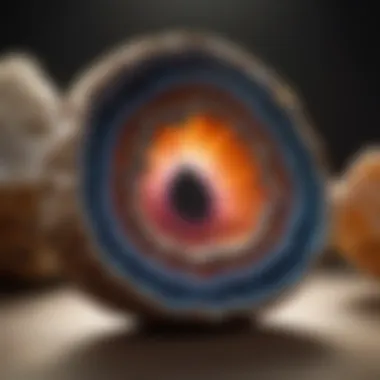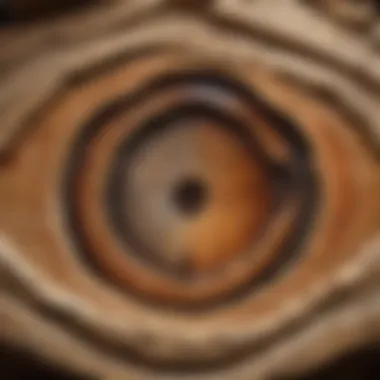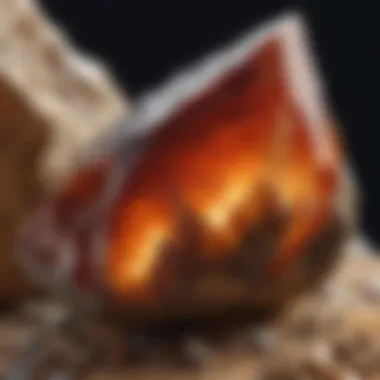Unveiling the Mastery of Large Lapidary Saws: A Comprehensive Guide for Rock and Fossil Enthusiasts


Rock and Fossil Identification
In unraveling the enigmatic realms of large lapidary saws lies a crucial aspect: rock and fossil identification. Understanding the types of rocks and fossils is paramount for collectors, as each specimen carries its own uniqueness waiting to be unveiled. When delving into this fascinating world, collectors must pay attention to intricate details and characteristics that define each specimen – from color variations to textures and fossil imprints. Tools play a pivotal role in this identification process, aiding enthusiasts in magnifying intricate patterns or inspecting tiny details that narrate the history encapsulated within each rock or fossil.
Collecting Tips and Techniques
Once the gems of interest have been identified, collectors venture into the intriguing realm of collecting tips and techniques. Best practices encompass a meticulous approach, ensuring that specimens are extracted without causing harm or damage. Locating prime collecting sites involves research and exploration, where geological formations reveal hints about potential fossil-rich grounds waiting to be explored. Safety is of utmost importance during the extraction process, requiring collectors to use tools appropriately and handle specimens with care to preserve their integrity.
Preservation and Display
The journey of a collector does not end with acquisition; it extends into the realm of preservation and display. Techniques for preserving rocks and fossils involve a delicate balance between protection and reveal. Proper storage methods are crucial in maintaining the integrity of specimens, shielding them from external elements that could alter their composition. Creative display ideas add an artistic touch to collections, transforming them into captivating showcases of Earth's history and beauty, offering viewers a glimpse into the mesmerizing world of geology.
Geological Insights
Beyond the tangible allure of rocks and fossils lie profound geological insights waiting to be unraveled. The formations and processes that shaped these specimens tell tales of Earth's history and evolution, offering a glimpse into the forces that crafted the landscapes we see today. Understanding the historical significance of rocks and fossils adds layers of depth to collections, connecting collectors to moments frozen in time. Notable discoveries in the field not only enrich the scientific community but also inspire collectors to continue exploring, seeking to unearth the hidden treasures scattered across our planet's surface.
Introduction
Rock and fossil collecting transcend mere hobbies; they are a passion that drives enthusiasts to unravel the mysteries of the Earth's ancient past. The introduction to 'Unveiling the Magic of Large Lapidary Saw' not only sets the stage for the journey you are about to embark on but also lays the foundation for understanding the pivotal role that large lapidary saws play in this intricate world. This section serves as a gateway, beckoning collectors to delve deeper into the realms of cutting-edge technology that will revolutionize their collecting experiences. By deciphering the essence and practical significance of large lapidary saws, readers are primed to elevate their craftsmanship and enhance the quality of their precious finds.


What is a Lapidary Saw?
At the heart of every rock and fossil collector's arsenal lies a fundamental tool – the lapidary saw. But what exactly is this marvel of engineering that has become indispensable for enthusiasts across the globe? A lapidary saw is not just any ordinary cutting device; it is a precision instrument meticulously designed to slice through the toughest of materials with unparalleled accuracy. Its origins trace back to ancient lapidary arts, where skilled craftsmen honed their cutting techniques to reveal the hidden beauty locked within stones and fossils. In contemporary times, the lapidary saw stands as a beacon of innovation, blending tradition with technology to offer collectors a window into the geological wonders of our planet.
Significance in Rock and Fossil Collecting
The integration of large lapidary saws into the realm of rock and fossil collecting marks a revolutionary shift in how enthusiasts interact with their prized specimens. No longer bound by primitive tools that limit their creative expression, collectors now have the power to unleash their potential through precise cuts and intricate shaping. The significance of large lapidary saws extends beyond mere functionality; it embodies a transformative journey where raw stones and fossils metamorphose into exquisite works of art. As collectors strive for perfection in every cut and slice, the lapidary saw emerges as a faithful companion, guiding them towards the fulfillment of their geological dreams.
Understanding Large Lapidary Saws
In this section, we delve into the critical aspect of understanding large lapidary saws, a fundamental topic that forms the backbone of rock and fossil collecting. Large lapidary saws, with their robust mechanisms and precise components, play a pivotal role in transforming raw stones and fossils into exquisite pieces of art. By comprehensively understanding these saws, enthusiasts can unlock a world of possibilities in creating stunning collections. Exploring the mechanics and components of these machines and grasping their functional elements is essential for anyone looking to elevate their lapidary work. Understanding large lapidary saws not only enhances the outcomes of cutting and shaping rocks and fossils but also ensures safety and efficiency in the overall process.
Mechanics and Components
Within the realm of large lapidary saws, the mechanics and components stand as the cornerstone of their operation. These saws are intricately designed with a multitude of parts working in synergy to achieve precise cuts and shapes. The motor, blade, arbor, vise, and cooling system are just a few components that form the intricate anatomy of a large lapidary saw. Understanding how each part functions and interplays with the others is crucial for optimizing cutting performance and ensuring longevity of the machine. By unraveling the nuances of these mechanics and components, collectors can fine-tune their saws to meet specific cutting requirements and achieve impeccable results.
Types of Large Lapidary Saws
When delving into the world of large lapidary saws, one encounters a diverse range of saw types, each tailored to different cutting needs and levels of expertise. From slab saws ideal for cutting through large rocks to trim saws designed for precision trimming, the market offers a plethora of options to suit varying requirements. Slab saws, trim saws, and combination saws are among the most common types sought after by rock and fossil collectors. Understanding the characteristics and functionalities of each saw type is essential for making informed decisions based on cutting projects and skill levels. By exploring the types of large lapidary saws available, collectors can identify the best fit for their specific needs and enhance their cutting experience.
Choosing the Right Saw for Your Needs


Selecting the appropriate large lapidary saw is a pivotal decision that significantly impacts the quality and efficiency of cutting tasks. Factors such as blade size, motor power, cutting capacity, and overall durability play a crucial role in determining the right saw for individual needs. Evaluating the intended use, frequency of cutting, and types of rocks or fossils to be worked on are key considerations when choosing a saw. Whether beginners looking for user-friendly options or seasoned collectors seeking advanced features, understanding the unique requirements and capabilities of different saw models is paramount. By carefully selecting the right saw that aligns with specific needs and preferences, collectors can embark on a journey of precision cutting and craftsmanship that elevates their collections to new heights.
Setting Up and Operating a Large Lapidary Saw
In the riveting world of rock and fossil collecting, the process of Setting Up and Operating a Large Lapidary Saw emerges as a crucial cornerstone. This pivotal aspect holds the key to unlocking the full potential of large lapidary saws, allowing enthusiasts to delve into the depths of precision cutting and intricate shaping with finesse. By meticulously setting up and operating these powerful tools, collectors can elevate their craft to unparalleled heights, achieving cuts and designs that transcend the ordinary.
A fundamental consideration when embarking on the journey of setting up and operating a large lapidary saw is safety. Prioritizing safety precautions is non-negotiable in this endeavor, as these saws wield immense power and require meticulous attention to operational protocols. Ensuring a secure working environment, donning appropriate safety gear, and understanding the machinery's safety features are paramount steps in safeguarding not only the collector but also the longevity of the equipment.
Calibrating the saw for precision cuts revolutionizes the cutting experience, paving the way for immaculate creations and seamless operations. Achieving precision cuts involves a meticulous calibration process that fine-tunes the saw's settings to align with the desired outcome. From adjusting blade speed to optimizing cutting angles, every calibration parameter plays a vital role in honing the saw's cutting precision, allowing collectors to craft pieces with unparalleled accuracy and detail.
Basic cutting techniques serve as the cornerstone of lapidary artistry, offering collectors a foundation on which to build their skills and unleash their creativity. Mastering basic cutting techniques involves understanding the fundamentals of blade control, feed rates, and material manipulation. Whether executing straight cuts or intricate curves, grasping these fundamental techniques empowers collectors to bring their artistic visions to life, transforming raw rocks and fossils into masterpieces of beauty and precision.
Maximizing Efficiency and Durability
In the realm of rock and fossil collection, the significance of maximizing efficiency and durability with large lapidary saws cannot be overstated. Efficiency plays a vital role in ensuring a smooth cutting process, saving time and effort for collectors. By maximizing efficiency, collectors can process a larger volume of rocks and fossils with precision and speed, ultimately enhancing their productivity and expanding their collections. On the other hand, durability is crucial in ensuring the longevity and optimal functionality of the saws. Regular maintenance and careful usage practices contribute to extending the lifespan of the saw, reducing the need for frequent repairs or replacements. It is essential to focus on both efficiency and durability to achieve sustainable and effective results in rock and fossil cutting endeavors.
Maintenance Tips for Longevity
To maintain the longevity of large lapidary saws, collectors should adhere to a strict maintenance routine. Regularly inspecting the saw for signs of wear and tear, cleaning all components thoroughly, and lubricating moving parts are fundamental maintenance practices that can prevent premature damage and ensure smooth operation. Additionally, proper storage of the saw in a dry and stable environment can prevent rust and corrosion, further enhancing its longevity. Investing in high-quality blades and replacing them when worn out is also essential for maintaining cutting precision and prolonging the saw's lifespan. By following a comprehensive maintenance regimen, collectors can preserve the functionality and durability of their lapidary saws for years to come.


Enhancing Cutting Performance
Enhancing cutting performance with large lapidary saws involves optimizing various factors to achieve precise and efficient cuts. One key aspect is selecting the right blade for the specific material being cut, considering factors such as hardness and density to ensure clean and accurate cuts. Additionally, maintaining optimal blade sharpness through regular sharpening or replacement is crucial for maintaining cutting performance. Adjusting cutting speed and pressure according to the material being processed can also significantly impact cutting precision and efficiency. Furthermore, calibration of the saw for specific cuts and employing advanced cutting techniques can further enhance cutting performance and achieve desired results. By focusing on these aspects, collectors can elevate their cutting efficiency and output quality, enhancing their overall rock and fossil collection endeavors.
Tips for Advanced Users
In this section, we delve deeper into the realm of advanced techniques for utilizing large lapidary saws. For aficionados and experienced collectors, mastering specialized methods can elevate cutting precision and create unique shapes and designs. Understanding these techniques unlocks a new level of creativity and allows collectors to push boundaries in their craftsmanship. Enthusiasts who aspire to distinguish their collections and showcase one-of-a-kind specimens will find invaluable insights in this segment. Exploring beyond conventional cutting approaches opens up a world of possibilities, where innovation and experimentation reign supreme.
Specialized Techniques for Unique Cuts
Specialized cutting techniques are the hallmark of skilled lapidary artisans. These methods involve intricate practices such as facet cutting, carving, and inlay work, where precision and attention to detail are paramount. By incorporating specialized blades, angles, and cutting patterns, collectors can fashion geometrically precise shapes or intricate designs into their specimens. These techniques require patience, practice, and a keen eye for detail to achieve flawless results. Whether creating custom gemstone facets or crafting delicate fossil inlays, mastering these techniques adds a touch of artistry to lapidary work that sets it apart from standard cutting practices.
Troubleshooting Common Issues
Even the most seasoned lapidary enthusiasts encounter challenges while operating large lapidary saws. Common issues such as blade wear, motor malfunctions, or irregular cuts can disrupt the cutting process and hinder project outcomes. Identifying these problems early and knowing how to address them is crucial for maintaining workflow efficiency and achieving desired results. By understanding the root causes of common sawing issues and implementing effective troubleshooting strategies, users can mitigate disruptions and optimize their sawing experience. From adjusting blade tension to calibrating cutting parameters, troubleshooting common issues is a fundamental skill that every lapidary saw operator should master for seamless cutting operations.
Conclusion
In the realm of rock and fossil collecting, mastering the use of large lapidary saws holds paramount importance. This equipment serves as a gateway to unlocking the true potential of the specimens one gathers. As we conclude this comprehensive guide, it is crucial to highlight the transformative effects that precision cutting can have on the quality and aesthetics of your collection. By honing your skills in using these saws effectively, you pave the way for elevating your curation to unparalleled levels of sophistication and accuracy. The precision cuts afforded by large lapidary saws not only enhance the visual appeal of your rocks and fossils but also enable a deeper exploration of their internal structures, providing valuable insights that may have remained hidden otherwise. In a world where attention to detail is revered, mastering the art of large lapidary saws sets you apart as a collector who values precision and excellence in every facet of their hobby.
Mastering the Art of Large Lapidary Saws
To truly master the art of large lapidary saws, one must first grasp the intricate mechanics that drive these machines. Understanding how each component functions and contributes to the cutting process is essential for achieving the desired results. Beyond the theoretical knowledge, practical experience plays a pivotal role in mastering these tools. Experimenting with different cutting techniques, adjusting blade speed and feed rate, and fine-tuning the saw for specific materials are all part of the learning curve. Moreover, developing a keen eye for identifying the optimal cutting angles and strategies for different types of rocks and fossils is a skill that comes with time and practice. By immersing yourself in the world of lapidary work and continuously seeking to refine your techniques, you unlock the full potential of large lapidary saws and elevate your craftsmanship to a level of true mastery.
Elevating Your Collection with Precision Cuts
Precision cuts are the cornerstone of a well-curated collection, distinguishing amateurs from connoisseurs in the world of rock and fossil collecting. By harnessing the power of large lapidary saws to achieve precise cuts, you significantly enhance the visual appeal and scientific value of your specimens. Each cut reveals a new facet of a rock's interior, unveiling intricate patterns, textures, and inclusions that add depth and character to your collection. Precision cutting also allows for standardized specimen sizing, making it easier to display and compare different rocks and fossils. Whether you are aiming for symmetrical gem cuts or meticulously dissecting a fossil slab, the precision offered by large lapidary saws enables you to showcase your specimens in their best possible light. Elevate your collection from ordinary to extraordinary by embracing the art of precision cutting and letting the beauty of your rocks and fossils shine through with clarity and finesse.







